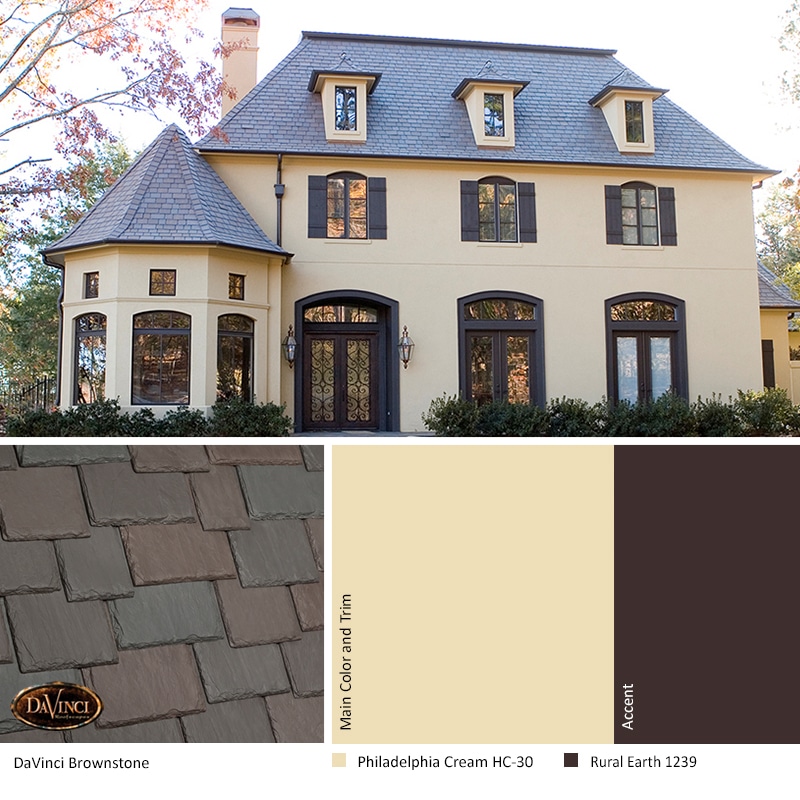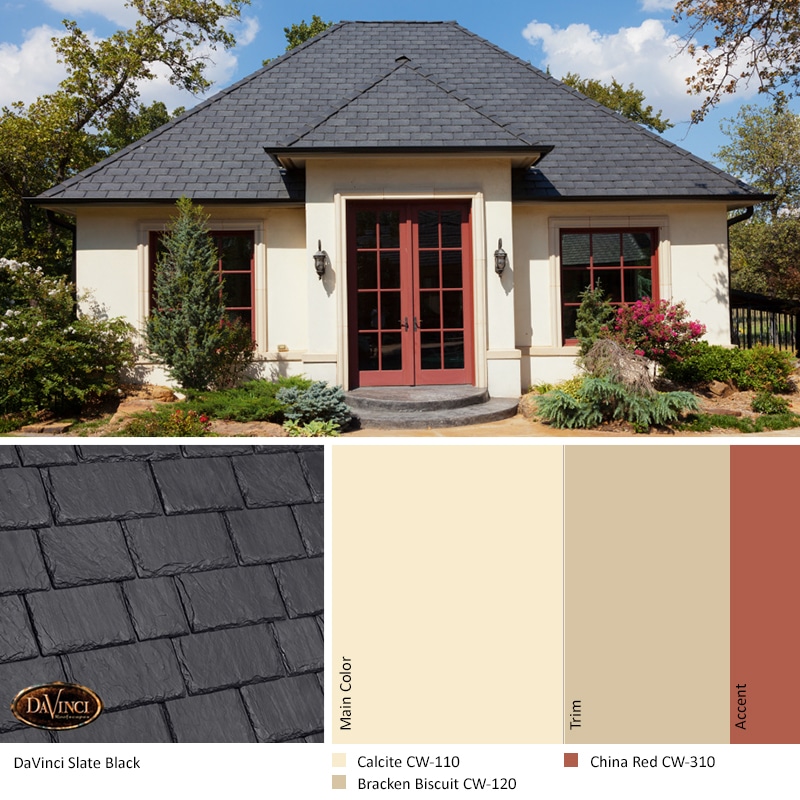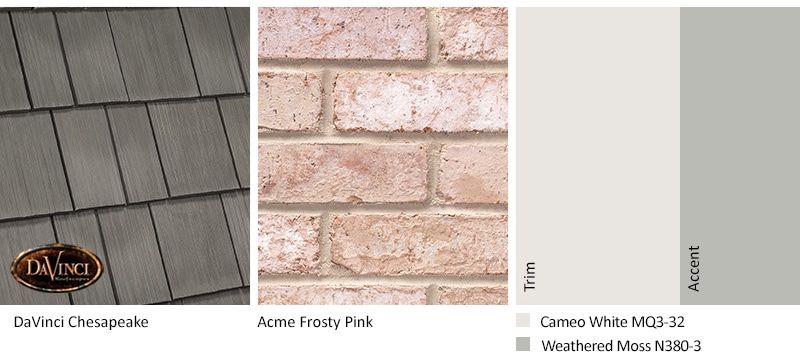Trim Color — How to Select the Best One for Your House
Would you like to know how to select the best exterior trim color for your home without frustration or anxiety? If so, keep reading. Today, I share my favorite tips and tricks for finding the right trim color.

Trim Color for Every Style Home
Traditionally homes have an exterior color scheme of three or four colors. The primary color is light to medium, with the trim being white, a lighter neutral, or a color. Accents such as shutters, doors, and secondary trim are darker and bolder, giving the home personality and creating a well-balanced arrangement of colors to draw attention to the house’s best features.

Do You Want the Trim to Blend in or Contrast with the House’s Main Color?
The first step is to decide on the primary color. I’ve written several posts to help you select your primary color.
- Selecting Exterior Colors 101
- What is a Fixed Feature, and Why is it Important When Choosing Your Colors?
- Best Exterior Color Scheme to Match Your DaVinci Roof
From there, determine if you want your trim color to blend or stand out. For example, white with black or dark bronze window grids work well for the modern farmhouse style. A larger stucco home often looks best with a monochromatic palette. If you are still deciding which you prefer, look at similar homes in your neighborhood or find pictures of similar houses online or in the DaVinci gallery to help you see which look you like.
Trim That is Similar to the Primary Color
Find a slightly lighter or darker color similar and at least two steps away from the primary color. You don’t want the body and trim colors too close in value (lightness or darkness). There are exceptions, such as a white house with white trim or historic homes painted in one color. When low contrast is the goal, go for lower contrast but not so close that you can’t see a difference between the two. Your trim pieces need to stand out enough to highlight the lovely details of your home. Below is an example of a low-contrast trim against the house’s primary color.

Contrasting the Color of Your Trim
To contrast, consider using a light or dark neutral, such as white, off-white, beige, brown, gray, or black. It is still essential to find a color in a tone that harmonizes with your house’s body color, even if you choose a neutral one. For example, if your home is a creamy light gold, your trim will blend if it has a bit of gold too. It could be a deep golden tan, or an off-white toned down with yellow.
Some painters advise homeowners to add 10-20% of their body color into a white base to create the trim paint. While this does increase the odds that the two will harmonize, I do not suggest this practice. It is tough to mix up the same color a second time, no matter how carefully your painter measures. Instead, have the paint store adapt the color to ensure you have a formula they can recreate if you need additional paint.

Contrasting Trim Color
To contrast, consider using a light or dark neutral, such as white, off-white, beige, brown, gray, or black. To contrast, consider using a light or dark neutral, such as white, off-white, beige, brown, gray, or black. Finding a tone that harmonizes with your house’s body color is essential, even if you choose a neutral color.
Even with charcoal or black, you want to coordinate the tones. Sometimes, black read dark and inky, but sometimes it has a touch of blue, green, red, or violet. If you have a blue or blue-green house, a black that leans a tad navy will be lovely. A bit of color in the black can make the trim or door read as black from a short distance and show a hint of color as your visitors get closer, revealing a more exciting paint choice.

Style-Inspired Trim
Another factor to consider is the architecture of your home. A classic white or off-white trim color is a safe bet if you have a traditional-style home. A Victorian may call for two or three accent colors. More modern homes may use the same color for the body and trim. Others are going bold with black, red, or teal to add a pop of color and personality.

Let the Location Take the Lead
When selecting a trim color, consider the surrounding landscape. If you live in a wooded area, you may want to choose a trim color that blends in with the natural surroundings, such as a deep green or brown. If you live in a desert climate, choose a trim color that complements the warm, sandy tones of the landscape, such as a soft beige or terracotta.
Trim with Bricks or Stonework
Selecting the right paint color to match a surface that incorporates multiple colors is challenging. To determine the type of trim you think will look best, decide between having contrasting trim or a color closer to the primary color of your home. If your house has brick or stone, you can choose one of the tones in the mix.

Avoid matching the stone or brick color at close range. Instead, stand back from your house closer to the curb to view color samples. You can see how well the hard materials and paint color blend by putting some distance between you and the bricks or stones.

When you stand back, your eyes mix all the colors on the surface of the bricks and stones. Because of this phenomenon, the color that works from a distance differs from the one you would have picked at a close range. Standing back lets you see the colors together as you and most people will view your house.

Test Your Trim Color
The next step is to try out the color by looking at samples outside your home:
- Start by looking at samples of the trim color alongside the primary color. Also, look at it alongside any other elements it needs to blend with, such as roofing, brick, or stone.
- Stand back about 15-20 feet and determine the most appealing color.
- Look at the color at different morning, afternoon, and evening times to understand how the trim color blends with the primary and accent colors.
- Finally, paint the trim color alongside the primary color on the actual material as a final check that you are happy with your choice.
Ultimately, the key to choosing the perfect trim color for your home’s exterior is to take your time and consider all the factors at play. Doing so can create a cohesive and visually appealing look that will make your home stand out.
Even More FRESH Ideas for Selecting Colors for Your Home Exterior
- For more help finding the perfect color scheme for your home, our ebooks offer easy-to-follow processes for choosing the colors in every part of your home. Download a free ebook.
- Visualize from roof to ground the products and colors that complement your home. Go to the DaVinci Color Visualizer.
- See pictures of homes and buildings that feature DaVinci Slate and Shake. Visit the photo gallery.
About the Author
Kate Smith is an internationally recognized color expert, consultant, and designer. She is a skilled colorist & a color consultant who, for more than a decade, has lent her expertise to DaVinci Roofscapes. Kate helps YOU select colors you will love for many years.
is an internationally recognized color expert, consultant, and designer. She is a skilled colorist & a color consultant who, for more than a decade, has lent her expertise to DaVinci Roofscapes. Kate helps YOU select colors you will love for many years.